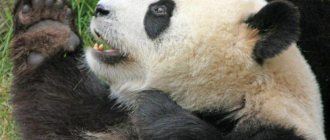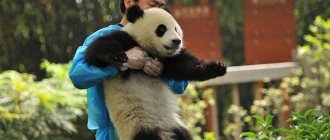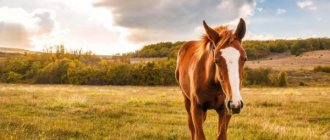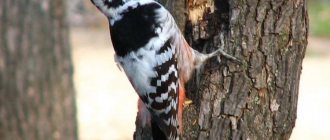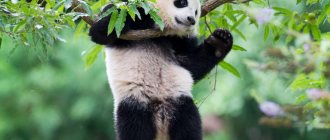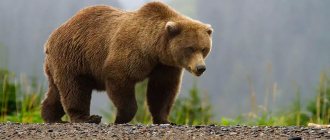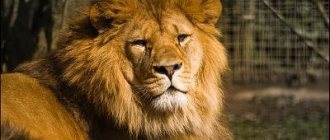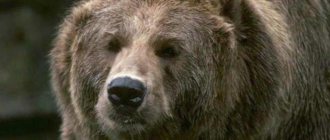The stylized image of the giant panda is the symbol of the World Wildlife Fund (WWF), and in its homeland, China, the panda is considered the personification of goodness and peace, because it does not eat living creatures. But the panda is more interesting than just a big bear eating bamboo. Therefore, we invite you to get to know this animal better.
There are six toes on a panda's paw
How to grow strong tomato seedlings with the right fertilizer?
Seedlings from old seeds: chamomile tea will “wake everyone up”
The strawberry harvest will increase many times: we water the bushes in the spring with garlic fertilizer
Unlike other members of the bear family, which have little or no dexterity in their paws, pandas have opposable "thumbs" along with five other fingers that help them hold bamboo and clear leaves from the plant's stems before eating.
Panda in Russian, and how to correctly call panda children!
PA?NDA, -y, female. Mammal of the family. raccoons (at that time the panda was considered a member of the raccoon family) Small p., Large p. (bamboo bear).
| adj. panda, -aya, -oe.
Ozhegov's explanatory dictionary. S.I. Ozhegov, N.Yu. Shvedova. 1949-1992
As we can see, from dictionaries, in particular from Ozhegov’s dictionary, the word “panda” is inclined. However, this word is not in word-formation dictionaries. Therefore, suffix formations of the name of panda cubs, according to the classical scheme: root + onok/enok, such as “ pandenok” , “ pandyata”, are considered non-literary. The correct name for panda babies is: panda cubs, panda cub and panda bear, panda cubs (similar to grizzly bear cubs), since the panda is now classified as a member of the bear family.
Pandas can be dangerous
Of course, pandas are usually carefree and cheerful, but don’t let anyone be fooled by their cute facial expressions and beautiful fur. These bears are not only able to crush you with their weight, but also have very strong teeth, muscles and jaws, which they use to crush hard bamboo.
It's easy to update an old countertop with concrete: a simple master class
The woman to whom Vladimir Gostyukhin has been married for 20 years
On March 20 they launched a burning wheel: rituals on the day of the spring equinox
Reproduction and lifespan
Pandas live most of their lives alone; only during the breeding season, which occurs in the spring, do males and females unite in pairs. The gestation period for a giant panda lasts from 3 to 5 months. As a rule, one cub is born, but rarely there can be two. Newborns weigh only 120 grams. When two babies are born, the female takes care of only one, and the second, abandoned to the mercy of fate, soon dies.
A giant panda gives birth once every 2 years, and sexual maturity occurs at 4-6 years of age. From this it follows that reproduction in this species is slow. Most likely this is due to birth control at the genetic level. That is, the low birth rate is due to limited food resources.
This fluffy miracle appears in a giant panda once every two years: more often than not, bears do not give birth.
Under natural conditions, the life expectancy of giant pandas is on average 20 years, but in a zoo, these bears live up to 30 years. One of the long-livers is a resident of the Beijing Zoo - female Ming-Ming, who died at the age of 34 years.
Panda is a calm animal
Menshikov and his young beautiful wife: why the couple has no children
This is against logic: why a child cannot manipulate his parents
American husband Mika Newton: how the singer, who emigrated to the USA, lives now
Adult pandas do not spend much time interacting with each other, and they are usually quiet. However, bears occasionally communicate through scent, squeaks, barks, growls or grunts.
Fact #1: The giant panda is much bigger than it looks.
When we look at photos on the Internet, giant pandas seem fluffy and cute. But they are much bigger than you think.
The weight of an adult panda can reach 150 kilograms, and the average length of a giant panda is 1.5 meters!
Find out more about what giant pandas look like: description, appearance, characteristic features.
Pandas climb trees deftly and swim well
We can finally find out why pandas are black and white
For years, scientists have speculated about why panda fur is colored the way it is. One position of zoologists was that this color helped the animals camouflage in forests of bamboo and snow, while the other suggested that the color of the bears helped maintain an appropriate body temperature, since black wool absorbs heat, and white wool reflects it.
How to determine when you can collect birch sap: rely on the weather
Nature generously endowed Ossetians with magical beauty: photo
The man thought he got a mini-pig: the pet “did not meet” his expectations
But in 2022, a study published in the journal Behavioral Ecology confirmed that the camouflage theory was in fact correct: white fur helps the animal hide in snowy habitats, while black fur is used for camouflage in the mountains. The study authors believe that the bears' black ears are a sign of aggression towards predators, and the black fur around their eyes helps them identify other pandas.
Little legend about Big Panda
“Black glasses” and a charming appearance provided pandas with not only recognition and wide popularity, but also universal love. There is a legend in China that explains the unusual color of these animals. That legend says that in ancient times, a family of shepherds settled on a mountain slope. Every morning, the shepherds took their flock of sheep to graze next to the bamboo thickets, where a white panda came to play with them. But one day a wild leopard attacked the peacefully grazing herd. All the sheep ran away in fear, and only the little panda did not have time to hide, because... I couldn't run fast. The wild leopard was already creeping up on its victim, and the panda would not have escaped a sad fate if not for the young shepherdess, who grabbed a stick and drove the terrible beast away from the little panda. But the shepherdess herself suffered greatly from the predator and died from wounds received in the fight. Having learned that the young girl had paid with her life for the life of their brother, the pandas wept bitterly and began to sprinkle themselves with ashes in honor of mourning for the dead. The pandas' grief was very great. Wiping away tears and consoling each other, they left black spots of ash on their snow-white skins. Since then, all the pandas have been mourning for the brave girl.
Some pandas do not reproduce for a long time
Scientific evidence suggests that giant pandas may unknowingly contribute to being listed as an endangered species. Female pandas can only mate two or three days a year, and some males don't know how to do it.
"Tian-Tian and Mei-Xiang, a pair of pandas who live together at the National Zoo in Washington, D.C., have not sired a cub in 13 years," says David Wildt, director of the Zoo's Center for Species Survival.
List of zoos that have giant pandas
Europe
Zoo Schönbrunn, Austria;
Madrid Zoo, Spain;
Edinburgh Zoo, UK (Scotland);
Zoo Berlin, Germany;
Zoo Beauval, Saint-Aignan, France;
Asia
Research Center in Chengdu, China
Kobe Oji Zoo, China;
Bei Jing Zoo, China;
Wolong Panda Breeding Center, Sichuan Province, China (temporarily closed)
Ocean Park, Hong Kong;
River Safari, Singapore;
Chiang Mai Zoo, Thailand;
Taipei Zoo, Taiwan;
Ueno Zoo, Tokyo, Japan;
Shiragama Amusement Park, Japan;
North America
Zoo in Atlanta (USA). Camera where you can watch a giant panda: https://www.zooatlanta.org/1212/panda_cam.
Memphis Zoo (USA). Video camera: https://www.memphiszoo.org/pandacam.
Smithsonian National Zoological Park in Washington (USA): https://nationalzoo.si.edu/Animals/GiantPandas/.
Zoo in San Diego (USA). Video camera: https://www.sandiegozoo.org/pandacam/.
Toronto Zoo, Canada;
South America
Zoo in Mexico City, Mexico;
Australia
Adelaide Zoo, Australia;
Pandas may soon be endangered
A final fact about animals is a sad reality. Despite the fact that pandas do not have many predators, there are about 1,800 of them left in the wild. This is the estimate of the World Wildlife Fund. The bears' conservation status of "vulnerable" is just one step above "threatened" status. The main factors for this situation are poaching and loss of habitat due to the construction of roads and railways.
Fortunately, organizations like the World Wildlife Fund are working hard to preserve panda habitats and populations for years to come.
Found a violation? Report content
It's interesting to know that...
- The bamboo bear first appeared in the USSR in 1957. The animal was brought to the Moscow Zoo from China. A panda named Pin-Pin became a treasure, and since 1959, the administration of the Moscow Zoo began searching for a partner for breeding the animal. The newly acquired bear, named An-An, disappointed workers when it was considered a male a few weeks after delivery.
Panda Pin-Pin at the Moscow Zoo
- The red panda was kept as a pet by families in India and Nepal in previous centuries.
- Chinese legislation reliably protects pandas, so since 1962 it has been prohibited to hunt bamboo bears. Penalty for violating this prohibition is the death penalty.
- The Chinese government leases pandas to foreign reserves for $1 million a year. There is a possibility of mating and the birth of babies. According to the established procedure and, despite the concluded agreement, the cubs are considered the property of China.
Little panda
- The red panda, interesting facts about which boil down not only to its exotic color, but also to its behavior, except in February and early March, lives alone because it values territoriality. Only after preparing to mate does the adult male look for a partner. In eight out of ten cases, the union ends immediately after this process.
- The black and white panda is revered in China because of the specific color of the animal, which combines the concepts of Yin and Yang. The study of the bear has been going on for 4 centuries, but even the rulers of previous years endowed the panda with philosophical meaning and certainly kept it at court.
Features and habitat of the panda
Bamboo forests, their dense thickets in China, the lands of the islands of Kalimantan and Indonesia attract pandas because these are the places that are suitable for hermits and in such places there are no problems with food.
In winter, the panda can sometimes fall into a half-sleep, but most often it behaves as in other seasons. Sometimes, if you are lucky, you can see this wonderful animal at the zoo, but this does not happen often because buying a panda animal is not so easy.
According to unofficial data, the panda price of the animal costs about $10,000. But in order to take her out of the country, a lot of paperwork must be completed, otherwise she faces imprisonment of five years or more.
Panda as a media character
The giant panda, with its very extraordinary color and appearance, is not only a natural heritage, but also a source of aesthetic consumption. Various artists and directors exploit the image of the panda, using it in their projects.
Pandaria is an entire fictional continent, the game world of World of Warcraft: Mists of Pandaria:
Panda from the cartoon "Tekken Blood Vengeance":
Po from Kung Fu Panda:
"Brave Big Panda":
The main character of the anime “Polar Bear Cafe” is also a panda:
"Panda: Path of War":
"Big Panda and Little Panda" (Panda, Go, Panda! 1972)
Ilya Sysoev - Panda from the series "Gamers"
Lifestyle and characteristic behavior
Red pandas are especially active at night . During the day, they usually sleep in nests that are located on tree branches or in hollows. When resting, they curl up and cover their heads with their tail. If the weather is hot, pandas lie on a branch with their paws dangling. Some researchers claim that sometimes during sleep the animal is in the same position as the American raccoon. That is, he sits on a branch with his head down on his chest.
After waking up or eating, the animal licks itself and rubs itself against the tree trunk. He climbs very well. In case of danger, it willingly takes advantage of this, seeking shelter at heights. Uses tail for balance.
On the ground it moves slowly and clumsily. Despite this, the red panda has to get the bulk of its food here. Food is brought to the mouth with the front paws and consumed in various positions:
- standing;
- sitting;
- lying on your back.
The animal resembles a raccoon or cat not only in appearance. No one knows exactly how many other features they have in common. For example, when excited, a puffing sound is made. A very similar one is used by raccoons. At the same time, the panda's back bends to intimidate it, like a cat's.
There are also peculiar behavioral features that are noticeable when communicating with representatives of their own species:
- Rocking in different directions, turning the head. Accompanied by clicking teeth.
- Stand on your hind legs, with your front legs above your head. At the same time, the panda looks attentively and intently at its relative.
- Slow “nodding”: alternating raising and lowering of the head. Accompanied by low and frequent panting. The tail is curved.
The usual sounds made by a panda are short screams. They are quiet, reminiscent of birds chirping. When stressed, the animal can snort and whistle. Some claim that during a conflict it stands on its hind legs like a bear.
The main enemies of the red panda:
- leopard;
- Snow Leopard;
- marten.
The red panda is a calm and non-aggressive animal. It behaves very quietly in the forest, lives separately from other representatives of the species. Each animal has its own territory. For females it is usually about 2.5 km², for males - 5 km². To indicate boundaries, special marks are used using:
- secretions of the glands located on the soles of the paws;
- anal glands;
- urine;
- litter
The listed designations also play another role. These are a kind of “questionnaires” that allow you to avoid close contacts while simultaneously exchanging basic information. With the help of tags, relatives are able to find out:
- floor;
- age;
- physical fitness, etc.
The red panda in the wild usually lives 8–10 years, in captivity - up to 14. The recorded life expectancy record is 18 years.
Related materials:
panda | bamboo | top | Guinness | rodents | attention | survival | opportunities | vigilance | Time | great love | wild animals | big eyes | wildlife | quickly | fight | China | young
Articles
- Helen Hunt. A fragile blonde with an iron character... June 15, 2011, 14:00
- Mom's stories March 12, 2012, 15:00
- Note to the bride. Off-site registration ceremony May 13, 2012, 15:00
Video
- Blue Lagoon by Swiss Line 05 August 2011, 15:24
- Idylle by Guerlain. History of creation October 25, 2011, 11:03
- The pinnacle of elasticity from VALMONT August 28, 2013, 10:00
Body structure, appearance
In size, a red or small panda is not much larger than a cat:
- length - from 50 to 64 cm;
- height (to shoulders) - about 25 cm;
- tail - 28–48 cm;
- body weight - 3.7–6.2 kg.
The head appears disproportionately large and wide due to powerful jaw muscles . There are other characteristic features:
- muzzle - short, sharp;
- ears - small, round;
- the eyes are bright black and small.
The paws are small but strong. You can count six fingers. However, one of them is actually an unusual wrist appendage. It is located opposite the fingers and helps to hold food.
The claws are retracted halfway and strongly curved. This allows for excellent tree climbing. The feet have long hair, so the red panda feels comfortable when moving on ice or snow. When walking, your feet only touch the ground halfway.
The color of the animal is very beautiful:
- the upper part of the body is from hazel to red, the head is lighter;
- back - red with brown or even black;
- on the back the tips of the hair are yellow;
- paws - black;
- muzzle - white;
- ears: inside - white, outside - dark red;
- the tail is red with “rings”.
An interesting feature of the muzzle is a kind of “mask” , very similar to the one that raccoons have. It is not for nothing that the red panda is also called the raccoon panda. It is difficult to count how many options for “masks” there are. They can be compared to human fingerprints.
This coloring provides excellent camouflage on trees. This is where most of the time is spent.
Documentary films about panda
Bear. The Bear: Spy in the Woods (2004) (BBC production, Steve Bunce) Thanks to a spy video camera, it was possible to capture unprecedented moments in the fascinating life of one of the mysterious and popular groups of animals. The star of the picture is a giant panda against the backdrop of Wildlife. You can learn about how this creature behaves and feels in a huge bear family. Compared to the life of the brown and polar bear, the panda's lifestyle is a striking contrast. An in-depth study of the life of wildlife will introduce the viewer to an equally famous animal - the spectacled bear, which is the only representative of bears in South America. You can see grizzly bears catching salmon; in the forests of Minnesota, we will watch black bears and their offspring climbing trees. Never in your life have you been able to get so close to real bears.
World of nature. Sleeping Dragon Pandas / The Natural World. Pandas of the Sleeping Dragon (1994) (BBC production, Liz Laidler, Kate Laidler) The bamboo forests of Central China are home to many species of rare and unusual animals. Our film will tell the viewer about those of them who inhabit the main Chinese panda reserve - the Sleeping Dragon Reserve. "Sleeping Dragon" is the poetic name of China's largest panda sanctuary. A great opportunity to get acquainted with the unique species of these “bamboo bears”, find out what, it turns out, there is a giant panda, a red panda, a water dragon, a bamboo rat...
Giant panda. Pandas on the loose / Giant Panda. Pandas in the Wild (2009) (produced by National Geographic, Japan, China, Tatsuhiko Kobayashi) A group of Japanese and Chinese filmmakers who spent a year and a half in the Quinlin Mountains in southwest China managed to make a unique film about one of the rarest animals on Earth - giant pandas. The humid climate of this harsh mountain region creates ideal conditions for the growth of bamboo, a plant that is the basis of the panda's diet. Giant pandas consume up to 18 kilograms of bamboo daily, which takes them 12–14 hours to complete. The rest of the time pandas sleep. For the first time, viewers will see footage of these amazing animals during courtship and mating, and will be able to watch how a female panda carefully cares for her newly born baby, who weighs just over 100 grams.
Giant Pandas: The Last Refuge (1994) (National Geographic production, Mark Stoffer) Together with a group of researchers from the National Geographic Society, you can go on an amazing journey to Central China, to the Chin Ling Mountains, where among the bamboo thickets and The inaccessible rocks are home to the rarest representative of the local fauna - the giant panda. You have a unique opportunity to find yourself in the closed world of these animals, whose population is on the verge of complete extinction. You will witness the life of a young panda, from the very first days of her life to adulthood. This is a touching story of a mother panda and her little daughter traveling through forests and snow-capped mountains. Many of the images you are about to see were captured by scientists for the first time. This film is the first step towards introducing a person to these charming creatures, who can teach us all a lesson in amazing kindness and tenderness...
